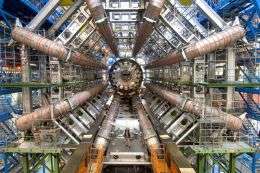LHC to run at 3.5 TeV for early part of 2009-2010 run rising later

CERN 's Large Hadron Collider will initially run at an energy of 3.5 TeV per beam when it starts up in November this year. This news comes after all tests on the machine's high-current electrical connections were completed last week, indicating that no further repairs are necessary for safe running.
" We've selected 3.5 TeV to start," said CERN's Director General, Rolf Heuer, "because it allows the LHC operators to gain experience of running the machine safely while opening up a new discovery region for the experiments."
Following the incident of 19 September 2008 that brought the LHC to a standstill, testing has focused on the 10,000 high-current superconducting electrical connections like the one that led to the fault. These consist of two parts: the superconductor itself, and a copper stabilizer that carries the current in case the superconductor warms up and stops superconducting, a so-called quench. In their normal superconducting state, there is negligible electrical resistance across these connections, but in a small number of cases abnormally high resistances have been found in the superconductor. These have been repaired. However, there remain a number of cases where the resistance in the copper stabilizer connections is higher than it should be for running at full energy.
The latest tests looked at the resistance of the copper stabilizer. Many copper connections showing anomalously high resistance have been repaired already, and the tests on the final two sectors, which concluded last week, have revealed no more outliers. This means that no more repairs are necessary for safe running this year and next.
"The LHC is a much better understood machine than it was a year ago," said Heuer. "We can look forward with confidence and excitement to a good run through the winter and into next year."
The procedure for the 2009 start-up will be to inject and capture beams in each direction, take collision data for a few shifts at the injection energy, and then commission the ramp to higher energy. The first high-energy data should be collected a few weeks after the first beam of 2009 is injected. The LHC will run at 3.5 TeV per beam until a significant data sample has been collected and the operations team has gained experience in running the machine. Thereafter, with the benefit of that experience, the energy will be taken towards 5 TeV per beam. At the end of 2010, the LHC will be run with lead ions for the first time. After that, the LHC will shut down and work will begin on moving the machine towards 7 TeV per beam.
Source: CERN

















